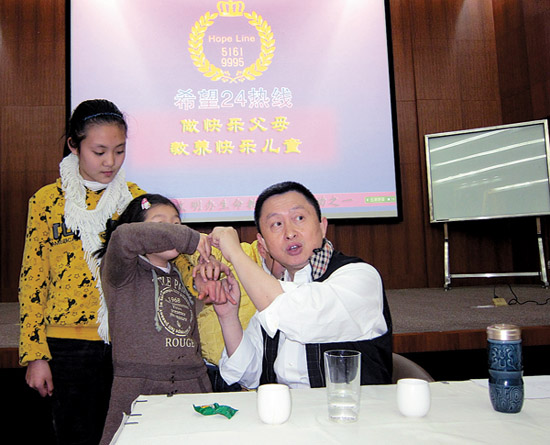
 |
| Lin Kunhui, founder of the Life Education and Crisis Intervention Center, conducts interactive programs with students in Shanghai. (China Daily) |
"In the classroom, we don't talk about life and death. What we do is to help them to find a sense of happiness. We want to help them build a stronger inner quality," he said.
The courses have been used in Taiwan's schools with good results.
"It is also time for mainland students to receive such new education," he said.
Every year, about 250,000 people commit suicide in China, while another 2 million attempt to cut their lives short, according to statistics from the Ministry of Health. Although studies show the highest incidence is among the elderly and rural women, the Chinese Center for Disease Control and Prevention says suicide is now the top cause of death for people aged 15 to 34.
In developed countries, 90 percent of suicides are connected to mental illness, but in China only a small proportion are the result of diagnosed mental problems, say experts.
Young people, especially those in puberty, take their own lives due to a lack of respect for life in general, said Liu Pengzhi, president of a middle school affiliated with Renmin University.
With increasing numbers of suicides and violence among the youth in recent years, Chinese experts now believe skills to cope with life should be an important part of the education curriculum.
The concept is just beginning to gain ground and is still strange to many parents. Courses are sometimes offered as extracurricular activities or organized by grassroots organizations.
"The essence of education is to help people to better know themselves and the world, and help them learn how to deal with the frustrations of daily life. But such education is absent from Chinese schools," said Luo Chongmin, a former Yunnan provincial education department director and a leading figure in education reform.
With Luo's support, Yunnan province launched an education program in 2008 called Sansheng, which in Chinese evokes three important concepts - survival, life and living. It is thought to be the first time education about life values was offered in a systematic way.
Sansheng education works as complement to traditional academics. Through a series of lectures, class discussions and extracurricular activities, students are taught the value of life, respect for people, how to adapt to different circumstances and enjoy their lives.
The model has since been adopted by millions of educators and parents in more than 18 provinces and cities.
Psychologist Yan Zhengwei said life education has an even wider range and includes the moral, physical and intellectual. Its dissemination should not only rely on schools and family because society as a whole also has a responsibility, he said
"Life education should be from kindergarten to middle school and college," he said. "Schools, families and the community should work together to give it to young people."

















 Our luxuriously departed Paper-made "luxury" goods replace paper money as top offerings to the dead during Qingming
Our luxuriously departed Paper-made "luxury" goods replace paper money as top offerings to the dead during Qingming


![]()
